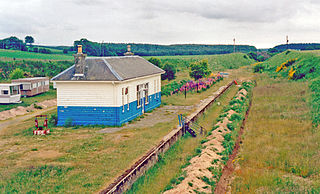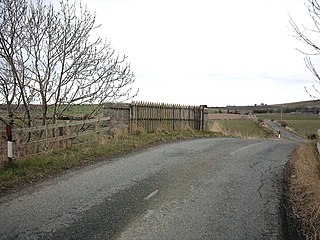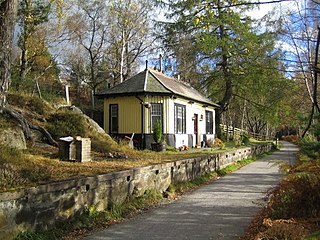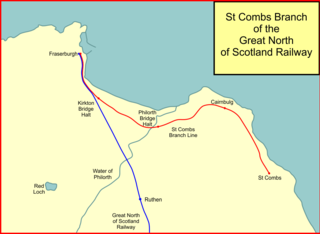
St. Combs railway station was a station on the Fraserburgh and St Combs Light Railway, Aberdeenshire. It was opened on 1 July 1903 and stood 5 1⁄8 miles (8.2 km) from Fraserburgh.

Cairnbulg railway station was a station on the Fraserburgh and St Combs Light Railway, Aberdeenshire. It was opened in 1903 as Inverallochy and was renamed Cairnbulg on 1 September 1903.
Philorth Bridge Halt railway station, not to be confused with Philorth railway station on the old Formartine and Buchan Railway, was a request stop on the Fraserburgh and St Combs Light Railway, Aberdeenshire. It was opened in 1903 as Philorth Bridge Halt and stood just to the east of Philorth Bridge, the Water of Philorth and the lane to Cairnbulg Castle.

Buckpool railway station was a railway station in Buckpool near Buckie in Moray. The railway station was opened by the Great North of Scotland Railway (GNoSR) on its Moray Firth coast line in 1886, served by Aberdeen to Elgin trains. The village and station were originally named Nether Buckie station and the station was renamed 'Buckpool' on 1 January 1887, closing to regular passenger traffic on 7 March 1960, several years before the closure of the line itself in 1968.

Portgordon railway station was a railway station in Portgordon in Moray, Scotland. The railway station was opened by the Great North of Scotland Railway (GNoSR) on its Moray Firth coast line in 1886, served by Aberdeen to Elgin trains. In 1923 the GNoSR became part of the London and North Eastern Railway (LNER) and at nationalisation in 1948 became part of British Railways. The station was named Port Gordon railway station until 1938 when it was renamed 'Portgordon' by the LNER.

Urquhart railway station was a railway station serving the village of Urquhart, parish of Urquhart, Moray. The railway station was opened by the Great North of Scotland Railway (GNoSR) on its Moray Firth coast line in 1884, served by Aberdeen to Elgin trains.
Calcots railway station was a railway station in the parish of St Andrews-Lhanbryd, Moray. The railway station was opened by the Great North of Scotland Railway (GNoSR) on its Moray Firth coast line in 1884, served by Aberdeen to Elgin trains. It served a rural area rather than a discrete settlement and closed to regular passenger traffic on 6 May 1968 on the same date as the line itself.
Findochty railway station was a railway station in the small fishing village of Findochty, Moray about 3 miles to the east of Buckie. The railway station was opened by the Great North of Scotland Railway (GNoSR) on its Moray Firth coast line in 1886, served by Aberdeen to Elgin trains.
Portknockie railway station was a railway station that served the small fishing village of Portknockie, close to Cullen in Moray. The railway station was opened by the Great North of Scotland Railway (GNoSR) on its Moray Firth coast line in 1886, served by Aberdeen to Elgin trains.

Cullen railway station was a railway station that served the small fishing village of Cullen, close to Portknockie in Moray. The railway station was opened by the Great North of Scotland Railway (GNoSR) on its Moray Firth coast line in 1886, served by Aberdeen to Elgin trains.
Tochieneal railway station was a railway station that served the small industrial village of Tochieneal, close to Cullen in Moray. The railway station was opened by the Great North of Scotland Railway (GNoSR) on its Moray Firth coast line in 1884. The station closed to regular passenger traffic on 1 October 1951, more than a decade before the total closure of the line itself in 1968.

Glassaugh railway station was a railway station that served the rural area of Glassaugh and the nearby Glenglassaugh distillery close to Portsoy in Moray. The railway station was opened by the Great North of Scotland Railway (GNoSR) on its Moray Firth coast line in 1884, served by Aberdeen to Elgin trains. The station closed to regular passenger traffic on 21 September 1953, more than a decade before the total closure of the line itself in 1968.

Ordens railway station was opened in 1859, its services restricted and renamed Ordens Platform railway station by 1911 and finally Ordens Halt railway station in 1924 with a restored service. The station was close to a farm of that name and served a very rural locality. The line from Tillynaught opened in 1859 and a temporary terminus opened on 30 July 1859 and a permanent station opened in 1860. There was a single platform.
Bridgefoot Halt railway station was opened in 1914. The halt was in the settlement of Bridgefoot close to the town of Banff. The line from Tillynaught opened in 1859 and a temporary terminus opened at Banff on 30 July 1859 and a permanent station opened in 1860. Bridgehouse Halt had a single platform and was opened by the GNoSR. The OS map of 1902 shows a 'Halt' at the site of the 1914 platform without indicating any structure at the site.

Golf Club House Halt railway station, also known as Banff Golf House Halt railway station was opened in 1914. The halt was located close to the town of Banff's golf club on the links. The line from Tillynaught opened in 1859 and a temporary terminus opened at Banff on 30 July 1859 and a permanent station opened in 1860. There was a single platform at the Golf Club House Halt, located on the shore side of the line and no provision for goods traffic. The OS map of 1902 shows a 'Halt' at the site of the 1914 platform without indicating any structure at the site.

Glenbarry railway station, previously known as Barry was an intermediate stop with a passing loop situated on the Great North of Scotland Railway (GNoSR) line from Cairnie Junction to Tillynaught. There were two platforms at Glenbarry that served the nearby hamlet that lies in what was once Banffshire. The line northwards ran to Tillynaught where it split to reach Banff by a branch line or Elgin by the Moray Coast line.
Knock railway station was an intermediate stop situated on the Great North of Scotland Railway (GNoSR) line from Grange and Cairnie Junction to Tillynaught. Knock served the rural community and later the Knockdhu Distillery in Banffshire. The line northwards ran to Tillynaught where it split to reach Banff by a branch line or Elgin by the Moray Coast line.

Cambus O'May railway station or Cambus O'May Halt, served Aberdeenshire, Scotland from 1876 to 1966 on the Deeside Railway. It was intended to serve the anglers on the River Dee, tourists, the 1874 Cambus O'May House hunting lodge and the local population of this rural district and stood 39 3⁄8 miles (63.4 km) from the Aberdeen (Joint) station. It was the last stop before Ballater.

The Fraserburgh and St Combs Light Railway was a short railway branch line built in Aberdeenshire, Scotland, to serve fishing harbours. It was built by the Great North of Scotland Railway (GNoSR), and it connected with the GNoSR at Fraserburgh.











